#Classification: Sometimes Dangerous
Explore tagged Tumblr posts
Text
Patient File: Lysandre
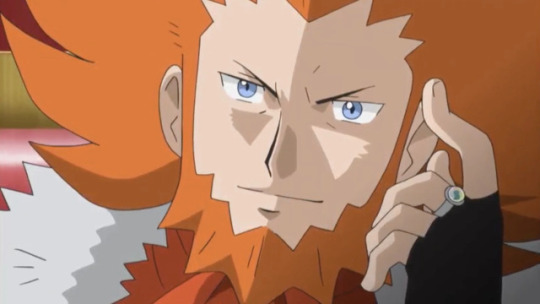
It's the 4th of July.....so naturally I'm analyzing a Frenchman.
In public, Lysandre is the head of Lysandre Labs, a charitable philanthropist responsible for the Holocaster technology used across the Kalos region. In secret, Lysandre is the boss of Team Flare, a criminal group that wants to wipe out all life in Kalos, and then the world, save for a chosen few that will restore the environment to its original natural beauty and purge all perceived ugliness from life.
The difference between Lysandre's public perception and his true self is quite stark. What led a man of privilege like him to such extreme, misanthropic beliefs? And is there anything that can remedy it?
To start with, it must be noted that Lysandre is descended from ancient Kalosian royalty, being the brother of the infamous King who built and activated the Ultimate Weapon of legend. This status warped Lysandre's view of people early in his life. It made him believe that certain people are inherently better than others, that they are "chosen" for greatness. This belief also placed a great sense of burden upon him, as he made it his life's mission to live up to that greatness. He saw it as his duty to provide for his region, to give to those less fortunate, to help shape a brighter future for everyone.
But Lysandre's ideals ended up clashing with reality. For everything he provided, there were people who misused or squandered it. For all he gave to the poor, he couldn't single-handedly solve income inequality meaning there were always more poor people in need. And for as much as he tried to create a better future, he ended up seeing signs everywhere of a worse on. Some signs may have been legitimate, many likely just in his own paranoid mind, but whatever the case it left him devoid of satisfaction and fulfillment. Being a man whose emotions burn fiercely, Lysandre began to feel deep hatred. Hatred for people who didn't notice or care about how they were affecting society. Hatred for the poor whom he saw as "parasites" who didn't fight hard enough to advance themselves in favor of taking from those who worked for their fortune. And hatred for things like deforestation, pollution, crime, war, and general lack of decorum. Lysandre became a misanthrope, seeing fault in everyone but himself and "chosen ones" that he deemed respectable like himself.
While Lysandre does feel remorse for the lengths he is willing to go to in order to cleanse the world of all that he perceives to be ugly, knowing it to be morally wrong, he keeps himself on this path anyway because he feels it's the only solution and that as a chosen one it is his burden to bear - that he has come too far to turn back now. Despite this, Lysandre is pathologically hypocritical. He wishes to be someone who gives, and yet his ultimate plan is to take the lives of many. He hates selfish, greedy and frivolous people and yet many such people make up the ranks of Team Flare all because they had a lot of money which Lysandre automatically thinks makes them self-sufficient workers who benefit society. And he considers himself to be an idealist even though his view of everything and what must be done about it is so deeply cynical. It's to the point where he can manipulate and threaten and do unimaginably cruel things while still insisting it's other humans, including his victims, that are the problem. In one famous instance, he wept for the Pokémon of the world that he felt he had no choice but to kill, saying as long as they exist humans will be tempted to abuse them as tools, making them and others suffer. He says this while he is enacting a plan that is abusing Pokémon as tools, making them and others suffer! The depth of his delusion and utter lack of self-awareness is stunning to behold.
Diagnosis: Lysandre suffers from a triple whammy of Paranoid Personality Disorder, Obsessive-Compulsive Personality Disorder, and Narcissistic Personality Disorder, with sociopathic tendencies as well even if he lacks the criteria to be a full sociopath. Treatment will be exceedingly difficult, but one aspect of his warped psyche can be used to the advantage of this end: his respect for fellow "chosen ones". Lysandre is not narcissistic enough to believe that only he has value, as he takes the views of other chosen ones seriously even if he disagrees with them - a prime example being his friend Professor Sycamore. If such people keep working with Lysandre to show him better alternatives to the problems he sees than his genocidal aims, it is possible that he will calm down and adjust to a safer way. It will take a lot of time and effort, but it is recommended as the only way to save him. For if he isn't saved, then the likelihood of self-destruction is great, and unfortunately Lysandre is a man with the will and power to take many others down with him.
This patient is sometimes dangerous. It depends on whether or not he views you as among the "chosen" or not. If he does, you may engage with him intellectually. If he does not, avoid at all costs.
#Pokemon#Lysandre#Patient File#Diagnosis: Narcissism#Diagnosis: OCD#Diagnosis: Paranoid#Classification: Sometimes Dangerous
13 notes
·
View notes
Note
Hi Thragg Junior Archivist here!
I have to ask what some of the weirdest creatures / non-human / object / inhuman ability you have seen
If you are not that open to my question, I fully understand, but I would love to give you this guy
1820011178 or wooly for short, he is a clump of wool that started to live
He is not dangerous. The classification code says it's not dangerous any way..
Anyway, enjoy his company. Make sure to give him enough sunlight.
Yours truly, Junior Archivist Samantha hugs, hugs, hugs
THRAGG LOVE WOOLY! wooly sound great! Thragg thanks Samantha Junior Archivist!
mmmm Thragg think. not human. weirdest objects and inhuman abilities
well first that come to mind is Agar and Igg, they human but have special connection to Dark Mother. Agar can see into future and Igg can perform spells and rituals to make incredible things happen. If Igg do one ritual it start to rain!
other than Igg and Agarmmmm Agar sometimes talk about snake peeple who live on tallest mountain? spooky place for anyone even snake peeple to live. She say they oldest ones who live here. not sure if they still around tho.
after that Thragg occasionally see a big bird during summers! Thragg call it Cloud Bird because it so large that when it fly over you it look like you being covered by big shadow.
Dust men!
Thragg think of Dust men! bad. come from over mountains to take and destroy and kill things. Scary Dust men with weird powers. Thragg have to fight off three many days ago cause they try to burn down forest.
Thragg hear about lots of weird objects. like Night fang! supposed to be a tooth from the mouth of Eyes in the night herself! said to be special. Thragg sometimes here about rocks in the swamps moving on their own. spooky.
OOO Thragg remember!
back when tribe was still wandering the wasted lands Thragg sometimes see weird peeple in the distance. dusty so it hard to see but they always looks like Thraggs family or friends. they wave at Thragg but never get close. like they want thragg to come to them? but Thragg have good eyes and see they look..... funny? lumpy? like they made of lumpy clay. Thragg never go neer them. to sucspicious.
Hope this helps! Junior Archivist Samantha!
58 notes
·
View notes
Text
Writing Notes: Frostbite
Frostbite - damage to the skin and other tissues caused by freezing.
Frostnip - a milder form of cold injury; it is sometimes described as the first stage of frostbite.
Some doctors use a 4-degree classification of injuries:
First-degree: The epidermis (outermost layer of the skin) is reddened, swollen, and may look waxy. There is also a loss of sensation in the affected skin.
Second-degree: The skin is reddened, swollen, and has formed blisters filled with a clear or milky fluid.
Third-degree: Blisters are filled with blood and the skin begins to turn black.
Fourth-degree: The epidermis, dermis, and underlying muscles, tendons, and bones are damaged.
The early stage of frostbite is sometimes called frostnip.
Short-term symptoms include:
loss of feeling or aching pain in the affected part,
followed by redness of the skin and
tissue swelling.
Unfortunately, a victim is often unaware of frostbite until someone else points it out because the frozen tissues are numb.
Long-term symptoms include:
intense pain in the affected part,
tingling sensations,
cracks in the skin,
dry skin,
loss of fingernails,
joint stiffness,
loss of bone or muscle tissue, and
increased sensitivity to cold.
If left untreated, frostbitten skin gradually darkens and blisters after a few hours.
Skin destroyed by frostbite is completely black, looks burnt, and may hang loosely from the underlying tissues.
Freezing of exposed tissues results in the formation of ice crystals inside the cell wall.
A variation of frostbite - mountain frostbite, which affects mountain climbers and others exposed to extremely cold temperatures at high altitude.
Combines tissue freezing with oxygen deprivation and general body dehydration.
TREATMENT
Frostnipped fingers are helped by:
blowing warm air on them or
holding them under one’s armpits.
Other frostnipped areas can be covered with warm hands.
The injured areas should never be rubbed.
While waiting for medical help to arrive, one should, if possible:
remove wet or tight clothing and
put on dry, loose clothing or wraps.
A splint and padding are used to protect the injured area.
The patient should not be allowed to walk on frostbitten toes or feet, as the weight of the body will cause further damage to tissue—unless walking is the only way the patient can get to shelter.
Rubbing the area with snow or anything else is dangerous.
The key to prehospital treatment is to avoid partial thawing and refreezing.
This releases more inflammatory mediators and makes the injury substantially worse.
For this reason, the affected part must be kept away from such heat sources as campfires and car heaters.
The injured person should not be given alcohol or tranquilizers, as these will increase loss of body heat.
Experts advise rewarming in the field only when emergency help will take more than 2 hours to arrive and refreezing can be prevented.
Because the outcome of a frostbite injury cannot be predicted at first, all hospital treatment follows the same route.
Treatment begins by rewarming the affected part for 15–30 minutes in water at a temperature of 104–108°F (40–42.2°C). This rapid rewarming halts ice crystal formation and dilates narrowed blood vessels.
Aloe vera (which acts against inflammatory mediators) is applied to the affected part, which is then splinted, elevated, and wrapped in a dressing.
Depending on the extent of injury, blisters may be debrided (cleaned by removing foreign material) or simply covered with aloe vera.
Except when injury is minimal, treatment generally requires a hospital stay of several days, during which hydrotherapy and physical therapy are used to restore the affected part to health.
Experts recommend a cautious approach to tissue removal, and advise that 22–45 days must pass before a decision on amputation can safely be made.
If frostbitten skin is not treated and its blood vessels are affected, gangrene may set in.
Gangrene is the death of soft tissue due to loss of blood supply.
It may be treated by surgical removal of the affected tissue if caught early; otherwise, the surgeon may have to amputate the affected digit or limb to prevent bacterial infections from spreading from the dead tissue to the rest of the body.
Source ⚜ More: Notes & References ⚜ Writing Realistic Injuries
#writing reference#writeblr#dark academia#spilled ink#writers on tumblr#literature#writing inspiration#writing notes#writing prompt#poets on tumblr#writing ideas#creative writing#fiction#medicine#frostbite#writing resources
123 notes
·
View notes
Text
—The Weight of Protection—
Love is a tricky thing.
It’s supposed to be soft, gentle. It’s supposed to be the warmth of a hand on your cheek, the quiet assurance that someone is watching over you. But sometimes, love is a cage. Sometimes, it is hands gripping too tightly, pulling you back from the ledge before you’ve even had a chance to decide if you want to jump.
Suguru Geto loves like that. Like a force of nature. Like inevitability.
He has always been protective—of Satoru, of his classmates, of you. Maybe too much. Maybe in ways that feel suffocating, but never quite enough to make you pull away. Because how could you? How could you resent someone who looks at you like you are the last pure thing in a world that is constantly trying to ruin itself?
He doesn’t just want to keep you safe. He wants to keep you untouched.
And that is where things begin to crack.
-----
“You don’t need to come,” you tell him once, tugging at the sleeve of his uniform as he moves toward the door.
Suguru doesn’t stop. He doesn’t even hesitate. “I’m coming.”
You sigh, because of course he is.
The mission isn’t even that dangerous—just a low-grade curse outside of town, something you could handle on your own. But Suguru doesn’t care about classifications. Doesn’t care that you’re more than capable of taking care of yourself.
He has already made his decision.
So you walk together, side by side, his presence a quiet thing that presses against your ribs, a reminder that he is always watching. Always keeping you within arm’s reach.
And you wonder if he even notices. If he even realizes how often he places himself between you and the world, how often he moves first, reacts first, takes the blow before you even realize there’s danger.
It is not nQ&Aormal, this level of devotion. It is not sustainable.
But he does it anyway.
And you let him.
-----
The first time you argue about it, it’s not even about you. It’s about Satoru. About their shared burden, about the weight of being strong in a world that expects them to bear the impossible.
“You can’t save everyone,” you tell him.
Suguru’s expression is unreadable. He is good at that—keeping his emotions folded neatly inside himself, like pressed sheets that will only unravel when no one is looking.
“You say that like I don’t already know.”
“Do you?” You step closer, searching his face. “Because it doesn’t seem like it. It seems like you’re still trying to hold everything together by yourself."
He looks at you then, really looks at you.
“You don’t understand,” he says quietly. “I have to.”
And you realize, with a sudden, awful clarity, that this is not just about protecting you.
That this is not just about keeping you safe.
This is about him. About the guilt curdling inside his chest, the way he still hears the voices of the people he couldn’t save.
He is trying to make up for something.
And you don’t know if he ever will.
-----
Suguru doesn’t sleep much.
You notice it in the way he carries himself, in the way his hands shake when he thinks no one is looking. He still smiles, still jokes, still acts like the same boy you’ve always known. But something is different.
Something is breaking.
“I can take care of myself,” you tell him one night, voice barely above a whisper.
He is sitting on the edge of the bed, hands folded between his knees, eyes trained on the floor.
“I know.”
“Then why—”
“Because I need to.”
It is not an answer. Not really. But it is all he gives you.
And you think: This is not protection. This is fear disguised as love.
You don’t know how to fix it.
So you let him stay.
-----
It happens gradually, then all at once.
The world tilts, the ground shifts, and Suguru is no longer the boy who laughed with you under the stars, who stole bites of your food when you weren’t looking, who stood too close but never close enough.
He is something else now.
Something colder.
You see it in his eyes, in the way his fingers tighten around the edge of his sleeve, in the way he looks at the world as if it has already disappointed him.
“You’re scaring me,” you whisper one day, after everything. After Riko, after the silence, after the distance that has grown between you like a chasm too wide to cross.
Suguru exhales slowly, tilts his head, considers you. “I don’t want you to be afraid of me.”
“Then stop giving me a reason to be.”
And for the first time, he hesitates. Just for a second. Just long enough for you to wonder if there is still a part of him left that wants to stay.
But then he says, “I can’t.”
And that is the end of it.
-----
There is a version of this story where Suguru does not leave. Where he stays, where he listens, where he does not let the weight of the world crush him beyond recognition.
But that is not this version.
This version ends with his back turned, with your fingers curling into your palms as you watch him walk away,
with the realization that no matter how much he loved you, no matter how fiercely he tried to keep you safe—
Some things cannot be saved.
Not even by him.
Not even by love.
And the cruelest part?
You understand.
You understand why.
And it doesn’t make it hurt any less.
-----
#jjk fanfiction#jjk angst#jjk x reader#jjk#jujutsu kaisen x reader#jujustsu kaisen x reader#jujutsu kaisen#jujutsu geto#geto suguru#jjk geto#geto x reader#jjk suguru#getou suguru x reader#jujutsu kaisen suguru#soft suguru#anime fanfiction#fanfiction#fanfic#fandom#anime x reader#anime#angst#jjk anime#character study#hurt/comfort#writers on tumblr#writerscommunity#female writers#writers#tragic
48 notes
·
View notes
Text
Classification of draconids encountered in the Dragonverse, defined by body types
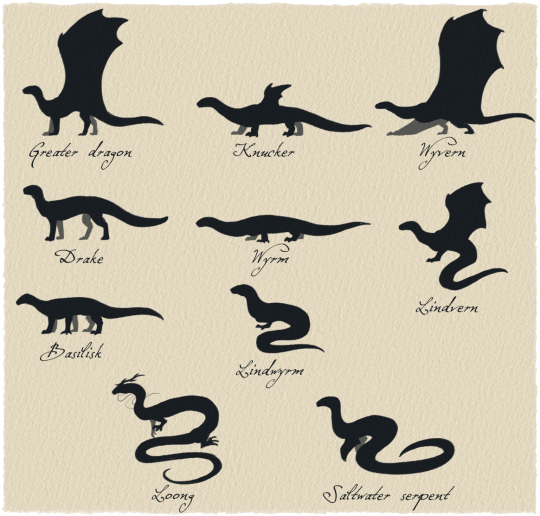
Greater dragons: one of the most iconic magical creatures first defined as "dragons", characterized by four legs, large wings and the ability to fly. Origin/natural habitats are mainly mountains and cliffs. Primarily highly intelligent, though there are a few "beast" species. Magic affinity varies, but the average power potential is higher than in most other draconid types. Rare even by post-dragon-war standards.
(The term "greater dragons" is often debated, but no suggested alternative ever managed to replace it due to the cultural effect of them being the first bearers of the "dragon" title. Originally, the group was even named "true dragons".)
Knuckers: while they share the limb count with the greater dragons, knuckers have shorter legs and small wings not capable of flight, instead aiding in swimming. Sizes vary from small to medium. Natural habitats are almost exclusively wetlands. Majority of species aren't capable of speech. Magically inclined towards water and biomatter magic, many species also possess venom glands. Uncommon.
Wyverns: exclusively flying type with a pair of hind legs. While they share many characteristics with greater dragons - varying sizes and magic affinity, preference for mountainous habitats, similar hunting behaviors - most wyverns are "beasts", which makes them one of the most dangerous draconid types. Gradual disappearance of greater dragons initially gave wyverns more hunting grounds, but that in turn attracted attention of dragon hunters. Nowadays large species are near nonexistent within human borders.
Drakes: one of the most versatile and adaptable types of draconids - which isn't very surprising, given their body plans (and consequently natural niches) resembling that of large predatory mammals. Primarily medium-sized dragons found in all kinds of land habitats and possessing various magic affinities, though their magical prowess is relatively low in "beast" species. Semi-common, though most avoid humans.
Wyrms: the type's belonging to draconids has been contended on multiple occasions, some people claiming them to be "just big magic lizards". The line between wyrms and reptiles does get somewhat blurry in a few cases, but the presence of "dragonstone" in their bones both grants them magical abilities and separates wyrms as draconids. (Notably, some reptiles are indeed magic animals without being draconids. The question of classification can sometimes only be solved through complex bone analysis.)
Wyrms are a versatile group with the largest range of sizes, some species being the smallest known draconids, while others are only outmatched by saltwater serpents and some ever-growing ancient dragons.
Lindverns are another controversial group of draconids, put into their own type after long debates about them being wyverns or lindwyrms. The fact that there are only two known species (both "beasts") does not help the matter. It's been theorized that they are a rare product of interspecies breeding - but lindverns do not share territory (wetlands and surrounding forests) with any known lindwyrms. Initially curtly named "pseudowyverns" or, as put by a frustrated draconologist, "a pain in the ass".
(Nab note: they actually evolved from knuckers.)
Basilisks: a particularly odd type of near exclusively beastial draconids featuring six legs and all sharing some degree of magical hypnosis ability (the myth of them turning creatures to stone stems from them using hypnosis to slow down/paralyze prey or opponent). Prefer forests and caverns in warmer climates. Uncommon type overall, with large species being very rare due to hunting.
Lindwyrms: (alt. spelling "lindwurms") serpentine draconids with a single pair of forelimbs. Medium-to-large in size, with only a few non-"beast" species. Found in various habitats, though they are the most common type of draconids in deserts. Most have magical affinity to water and/or air magic.
Loongs: exclusively intelligent, highly magic-dependent draconids capable of flight despite most species lacking wings. Due to there being no beast-like loongs, their existence is mainly unknown to humans. Have a strong affinity to water magic, though their energy is highly versatile, a trait shared with some greater dragons'. Most prefer to keep to themselves rather than hide among humans, very lengthy lifespans making long-term connections both risky and emotionally difficult.
Saltwater serpents: a group of large-to-colossal species with a self-explanatory type name. Most are creatures of legends, their habitats, rare appearance in human-controlled waters, and sheer power making surviving records of them near-nonexistent. Even other dragons rarely know much about their ocean-dwelling cousins.
#Dragonverse!Arcana#the Arcana worldbuilding#Nabesimart#nabs writes#the ''guide'' is not 100% reliable mind. Arcana draconology is full of classification debates
28 notes
·
View notes
Text

Well I.....
I don't know....
Name:Lepterix(Lepterix confusus)
(Lepus = Hare + Pteryx = Wing/Feather + Confusus = Confused)
Classification:
Family: Avian-Mammalian Hybrid (distinct from true birds or rodents)
Type: Omnivorous Cursorial Flier
Habitat: Open plains, rolling hills, and ancient ruins
Size & Build:
Height: Around 1.8 meters (6 feet) at the head when standing upright.
2.5 meters (8 ft) wingspan
Hollow bones, extremely lightweight (10-12 kg / 22-26 lbs)
Long hare-like legs for fast ground sprinting
Small rodent-like tail for balance
Bright, nonsensical color patterns that scream "I am venomous" but I’m not.
Abilities & Behavior:
Acrobatic Escape: Can jump, twist, and actually kick really hard… when remember it can do that.
Sprinting Disaster: Fast as hell but no sense of direction.
Flight? Almost. It flaps like crazy but mostly just violently glides into things.
Mimicry Attempt: It tries to hiss like a snake but usually just makes a confused squeak.
Zero Object Permanence: Hides food, forgets where. Finds food, surprised every time.
Will Eat Rocks. No one knows why. It does not digest them.
Panic Reflex: If confused (which is always), it honks loudly and runs in a random direction.
Surprisingly Durable: Somehow survives despite throwing itself into trees, walls, and rivers.
Intelligence Level: Rock.
Absolutely no survival instincts.
Runs full speed into walls constantly.
Will forget why it started running in the first place.
If threatened, it will stare blankly for three seconds before remembering to run.
If left unattended, it will forget what it was doing within seconds.
Runs toward danger just as often as away from it.
Will attempt to eat anything that fits in its mouth.
Can and will get stuck in places that shouldn't even be possible.
Easily distracted by movement, light, and sometimes just… nothing at all.
How can this thing survive in the wild?
Social Structure:
Lives in flocks of equally dumb friends.
Accidental Teamwork: If one panics, they all panic, causing stampedes.
Mates for Life (Somehow): If two bond, they stay together… mainly because they both forget to leave.
Extreme Herd Mentality: If one randomly starts running, the others immediately follow—even if they don’t know why.
Diet:
Omnivorous: Eats insects, berries, nuts, small lizards, rocks, and fungi
Magpie Instinct: Fascinated by shiny objects, collects them in burrows
Domestication & Uses:
Messenger Animal? Only if you want the message delivered to a tree.
Living Alarm System: Will screech at literally nothing in the dead of night.
Fashion Statement: Some nobles keep them as status pets, but mostly as a joke.
#art#original story#original character#fairytale#fairy tales#fantasy creature#creature#creature design#creature art#monsters#magical creatures#legends of the written realms#fablewood academy#fablewood#lowr#medieval monsters#medieval art#medieval#middle ages
20 notes
·
View notes
Text
A recall of a range of vegetable products due to potential contamination with Listeria monocytogenes has been issued the highest risk classification by the U.S. Food and Drug Administration (FDA).
And Go Concepts LLC, doing business as Salad and Go, a Texas-based company, announced a voluntary recall for the products on May 27.
The FDA subsequently issued a Class 1 risk classification for the recall on July 11.
Newsweek contacted And Go Concepts LLC for comment by email outside of regular working hours.
Why It Matters
A Class I risk classification represents "a situation in which there is a reasonable probability that the use of, or exposure to, a violative product will cause serious adverse health consequences or death," according to the FDA.
Listeria infection, or listeriosis, may lead to a range of symptoms in infected individuals. For those experiencing less severe infections, symptoms may include fever, muscle aches, nausea, vomiting and diarrhea, which often last between one and three days, the FDA said.
For more severe and potentially life-threatening infections, symptoms may include headaches, stiff neck, confusion, loss of balance and convulsions.
Severe infections are particularly dangerous for young children, frail or elderly people, and those with weakened immune systems. It can also lead to miscarriages and stillbirths in pregnant women.
What To Know
The products affected by the recall include the following:
Red cabbage, shredded - 1 case - codes: 2514111 / 2514111B
Onion, red diced - 8 cases (80 bags) - codes: 2514111 / 2514111B / 2514211 / 2514211B / 2514311
Cucumber, sliced - 8 cases (80 bags) - codes: 2514111 / 2514311
Pepper, red bell chopped - 31 cases (220 bags) - codes: 2514111 / 2514111B / 2514311
Carrot, shredded - 16 cases (195 bags) - codes: 2514111 / 2514311
Tomato, grape - 141 cases (565 bags) - codes: 2514111 / 2514111B / 2514211
Potato, cooked breakfast - codes: 2514111 / 2514111B / 2514311
Brussels sprouts, roasted - 71 cases - codes: 2514111 / 2514111B / 2514311
The products were distributed in Arizona and Nevada.
What People Are Saying
Mary O'Riordan, a professor of microbiology and immunology at the University of Michigan Medical School, told Newsweek previously: "Listeria has an unusual capacity to grow at refrigerated temperatures. Although the bacterium can contaminate many types of food, cheeses or deli meats that are kept in cold storage for long periods in stores or at home are a place where listeria can keep growing.
"Early symptoms of listeria infection look similar to other common foodborne infections, including fever, diarrhea and vomiting, so it's often not diagnosed right away. Unfortunately, sometimes listeria can spread into the brain and cause more serious illness, like meningitis. In those cases, if people experience headache, stiff neck or confusion, they should seek urgent medical attention."
Haley F. Oliver, a professor of food science at Purdue University, told Newsweek previously: "Listeria monocytogenes is a common microorganism that can be found in the natural environment, for example in soil. There are many factors that determine if someone gets listeriosis—a listeria infection. In most instances, an immunocompromised person—so young, old, pregnant or otherwise immunocompromised—must eat contaminated food. The number of bacteria resulting in infection and the amount of time before illness varies considerably. Symptoms vary among people but can include fever, flu-like symptoms, headache, stiff neck, confusion and loss of balance."
The FDA says on its website: "Pregnant women and their unborn or newborn baby, adults over the age of 65, and those with weakened immune systems, are all considered to be high-risk groups that are susceptible to the serious and adverse effects of listeriosis."
What Happens Next
The recall is listed as completed, according to the FDA.
14 notes
·
View notes
Text
Pet whump society headcanons
CW: Dehumanization, systemic pet whump, ableism (mention of “changelings”), allusion to apartheid with “pet only” facilities, ageism and allusion to putting pets down, yeah it gets pretty dark
How are pets dressed?
Pets would have a specific vibe of clothing or hairstyle, so it would be easy to pick them out of a crowd or sense they don’t belong. I’m thinking “fun” haircuts like wolf cut, mohawk, elaborate braids and buns. Or hairstyles that are very easy to maintain, shaved or effortlessly short and messy.
Clothing would be an overcommitment to a certain aesthetic, depending on the owner’s tastes. Usually bold and gaudy, or an uncomfortable style made to show off the pet’s best qualities.
The punk crowd could keep wearing these too, to show solidarity against pet ownership. And boomers get angry at the youths for dressing like pets just because it’s “trendy”.
That may also cause clashes with the cops or pet control departments, if they keep stopping people who “look like” pets.
Do pets have to crawl?
I mentioned in my story about Honey that only rich assholes with too much time on their hands make their pets “trot” on hands and knees everywhere they go. While it’s wrong to make your pet walk upright for too long (can be dangerous and exhausting), it’s not a good idea for them to trot outside or in most public places, as the ground is dangerous and unsanitary. Most of the time it’s acceptable for them to walk. That is, unless they’re inside a house, in which case it’s up to the house owner to determine.
Sort of like “a no-shoes household” —not everybody cares, but it’s generally polite and acceptable for pets to trot then, even if they wouldn’t normally. Sometimes the same holds true for working/service pets, made to trot within an office or classroom, whereas they would stand and walk around the rest of the facility with their owner.
They’ll generally sit or kneel on the ground when not moving, whether in public (on a train, at a restaurant, in a library) or in private. Many public places have designated plastic or rubber pads for pets to sit on, next to human seats and below tables.
Do pets use their hands?
I also made a note that while pets are still considered to have “hands” and not generally prevented from using them (not bound into paws or anything), it’s generally frowned upon and considered bad training if a pet uses it’s hands. This is because pets are silly little creatures who don’t know their own strength, and tend to hurt themselves or others if allowed the same mobility a human has. They’re basically allowed to use them as a primate might, holding food (not utensils) and drinking from them, moving a pillow or playing with a toy. But they shouldn’t be opening doors or doing more complex things like using tools (drawing/writing implements, hairbrush/toothbrush etc).
How long have pets been around?
Pet theory has been around for hundreds of years, but emerged as an evidence-based sociological/governmental designation comparatively recently. Pets have been scientifically classed and evaluated for since the late 1800s, although for many years after, only the upper class was able to afford evaluations for their family and peers. The caretaking of pets was seen as both luxury and philanthropy. While some families were shocked to learn that theirs included pets, many understood the necessity of revealing pets through scientific inquiry, as research would later show the rapid quality of life increase for pets who no longer have to play “changeling” and were treated appropriately with medication and training. It became common for rich families to evaluate prospective matches and employees for pet classification, and they often adopted those who were discovered, a generous act lauded by many pet conservationists. Nowadays pets are more commonly found and more affordably adopted, as testing procedures have simplified and become mandatory for most jobs and some cultural events, such as acquiring a marriage license or passport.
Do pets speak?
Pets are trained to rely on their caretaker to provide, and to not focus on their confusing pet thoughts. It isn’t good for a pet to engage in prolonged communication, so giving a pet small commands is most appropriate. Pets should be encouraged to reply with expressions, actions, or humming vocalizations. Some owners choose to correct their pet’s unnecessary vocalizations by trimming the hyoid bone, docking (shortening) the tongue, or (for the wealthier owners) undergoing a procedure in which a selective aphasia is triggered in the pet’s brain, keeping their comprehension in tact but limiting output ability.
Pet peeve question: pet hygiene?
Well trained pets can use the same restroom facilities as humans do. Because they’re not so dexterous with their hands, bidets are a universal commodity (lol idk - guys I really don’t want to make any pet owners rely on diapers or soemthing eugh)
It’s recommended that owners alternate sponge bathing and fully bathing their pets, checking their hygiene daily. They should also consistently brush their pet’s teeth and/or give them brushing toys to gnaw on.
It’s recommended that pets visit a care center for checkup every three months once fully trained, to ensure both physical and emotional well-being.
Pets in training should return to their home facility at least twice a week to get proper care.
Are there any older pets?
As pets age their appearance and mobility can suffer, as well as their emotional and mental well-being. While pet research is advancing and always finding new solutions to prolong the wellbeing of a pet, current projections note that a pet’s lifespan is generally between 25 and 35 years, depending on the age of pet status acknowledgement. If pets are found at a later age and do not receive proper care in time, they will generally suffer complications and resist training, requiring end of life care earlier than a well-trained and stable pet.
25 notes
·
View notes
Text

Had a hell of a time trying to upload this lmao. Doodles to accompany a ramble about my silly horrorverse/metathesiophobia/worldbuilding ramble that's very large so it's under the cut. It's as much Ella lore as it is Elliot lore :3c there might be some grammatical errors but idc I've tried to upload this 7 times now and don't wanna reread it lol
"Most organizations classify them as extinct, caused by villages hunting them and a lethal mutation in the survivors saliva, there are theories there are a few hidden surviving members, their numbers being merely in the single digits. Lycanthropy is not a 'one size fits all' type of curse/disease/parasite, it's classification is still being debated today, and it adjusted both according to it's host and to it's surroundings when it developed.
Before the lethal mutation, an infected person's lycanthropy could vary extremely in the first few months as it got a grasp on what was a normal environment for the individual. All recorded cases fit the 'true' werewolf classification. For people who gained Lycanthropy through genetics, bloodline werewolves, a vast majority were only slight variations of the 'true' werewolf.
-
The 'true' werewolf was most rampant back in the medieval ages, up until the mid 1800's, as to the Lycanthropy it was the peak time one could live 'naturally' and also a lack of constant danger while also having a sense of community. Although they were still bloodthirsty monsters, they held themselves back from ravaging people their host knew and hunted only strangers, even avoiding children if the host's morals were strong enough. They only hunted what they needed for the night, a person or two at most. True werewolves had very mild control of their curse, only being able to transform on command in dangerous situations. These transformations were relatively quick, taking less than 20 seconds, but remained agonizing as let the host take control until they were able to calm down in a safe area.
Sometimes an extreme burst of negative emotion could make part of their body rapidly transform to physically deal with the source of the stress, but it would result in the skin tearing due to the speed of it. Lycanthropy will only rip itself apart when it senses an emergency, a knee-jerk reaction if you will, to something in front of it. The last recording of a 'true' werewolf was in 20██, █████, Australia, however she had been found dead in her home. The cause of death was blood loss, caused by a silver laced bullet wound. For details about this report, please send a request to Dr. A. Whitelock.
-
Socialite werewolves are an extremely modern and elusive mutation of Lycanthropy. They are the sole reason the theory lycanthropes could still be alive today holds any water. Unlike 'true' werewolves, who could be anyone, all Socialite werewolves have been people who have lived in lavish luxury for the important developmental years in a bloodline werewolf's life. They are physically the weakest recorded mutation. The main theory for this is that the Lycanthropy adapted to learn that social power among regular humans is far more valuable for survival than hunting them for sport and changed to make transformation less intensive and more 'suitable' for it's new survival strategy. They were able to transform in around ten seconds on average, one recorded process shows them morphing with little to no pain visible on their face. The host confirmed that the Socialite werewolf's transformation is far less painful by saying: "A muscle cramp is only a touch more painful." This has enabled the few recorded individuals to amass groups around themselves, as they all publicized their lycanthropy. Most simply saw them as role-players with good 'fur suits' due to the fact the host's hair style remains unchanged while turned.
The last recorded socialite werewolf was in 19██, a popular rock star who had unfortunately overdosed on theobromine, the news had covered it as a 'normal' drug overdose and were forced forge it as a cocaine OD.
-
Brute werewolves are a debated topic, as some think we should classify them as Werebears instead, but all recovered remains confirm that their bone structure was far closer to a wolf than a bear's.
They are also debated to be a separate anomaly all together as they were initially thought to be a prehistoric megafauna before the bones were carbon dated to be only a few hundred years old. The term 'werewolf' was only applied to these bones upon the recovery of a library curated by a 'true' werewolf back in 1874.
According to literature in the library that claims to be history, Brute werewolves were thought to be lycans who had gone mad or were born to an accursed mother. Additional notes glued to the book claimed that they were simply those in the bloodline who had been tormented for a prolonged period of time, through they admit the 'cursed mother' could be part of it. Brute werewolves were described to be barbaric, rabid beasts that would rip apart anything with a heartbeat in front of them, only being satisfied when it had gorged itself on fresh meat and then some. There are drawings of Brute werewolves fighting packs of 'true' werewolves and descriptions of Brute werewolves being the cause of many deaths.
Despite the descriptions diminishing them as low intelligence beasts, they were said to speak in wails, attracting anyone to try to help the supposed person in danger, unknowing that they were the person in danger themselves.
Their transformations were said to be horrific as bone popped skin that ripped off muscle, their size was far to large to properly form from a regular human body. It is described to be a 'painfully long' process, so we assume it took over a minute for them to fully transform.
There has never been a case of an alive Brute werewolf, let alone a fresh corpse. We believe that if they are truly a mutation of Lycanthropy, they were the fist subsect to go extinct due to their heightened aggression that would have made it impossible to survive within the past 200 years. We hope that is the case."
7- █ - 202█ - Author Dr. Abigail Whitelock. Sources - ██████ - ██████████ -██████
#lizard's art#ella greenwood#werewolf#werewolf oc#elliot greenwood#dr. abigail whitelock#ramble#writing
41 notes
·
View notes
Text


HEHEJHDKSJ I HAVEN'T FINISHED HIS SHEET YWT :'''))) WIP WIP WIP
Mirou's former caretaker. Also him and his former caretaker's daughter (Kore). She's a junior researcher, only freshly graduated from college. He just puts papers on her head and reads from it sometimes but she doesn't really mind him using her as a reading desk. At least she gets paid enough to tolerate it.
I'm dropping lore here before my goldfish ahh memory forgets. At least if I forget, Ik I'll be scrolling here and end up reading it again.
Ophidianites (snake type demi-humans or nagas or whatever monster fuckers call them. I just wanna make their classifications nicer since I call the bird types "Aliferans" 👀) are larger, stronger, and much more dangerous compared to humans. Even some one who's as docile and domesticated as Mirou is usually treated and monitored cautiously by the facility.
Their venom has more times the potency of their regular snake counterparts. Like, let's say Mirou (I based him off of a leucistic cobra) accidentally bites you with fangs retracted. He can deliver 1000 - 2000 mg of a concoction of neurotoxins, cytotoxins, and cardiotoxins. Pretty lethal :3
hey have a mostly meat-based diet since regular human food doesn't really give them any nutritional value. They still indulge in human foods sometimes tho, especially sweets.
MINORS GO AWAY SHOO RRRAAAAAA 🦟🦗🦟🦗🦟🦗
Tite :)))
Anyways my friends bribed and begged me for 3 days straight to draw Mirou double stuffing Kore. I think it looks ugly idk I just have a natural hatred for my own snu snu art.
I haven't even finished his character sheet yeeeet aaAAAAAAAHAHAHAJAHSK *falls to the ground in defeat, and starts ripping into the grass while screaming*

(no uncen because I am insecure and I don't like posting uncensored nsfw when I feel like I didn't put enough effort into something. This is just an rkgk and it has tons of flaws so... *disappears ungracefully*)
Also wow my first gooner art in 2024?? I'm never(?) doing that again hahaaaaa


Dat is all. Enjoy my cringe doodles.
#taong ahas sa Robinsons /j#wwawawawayayyayyYYyshskbayayayayaya#✿pipOCs▾▾▾#✿pipWIPs▾▾▾#✿piprambles▾▾▾
48 notes
·
View notes
Text
Pheromosa
Pheromosa (#795)
Pheromosa pheromosa
General Information: Pheromosa is a charming creature of the Ultra Desert, known by some astrobiologists as “Ultra Beast-Beast.” It is a tall, graceful, and flexible creature that vaguely resembles a weird human and a cockroach hybrid that became a fashion model. They release a powerful pheromone that cause most creatures to fall in love with it!
Pheromosas average at 5’11 feet (1.8 M) tall and weigh about 55.1 pounds (22 kg).
Special Ability: “Pheromones,” this ability causes any Pokémon/human/Ultra Beast/etc., who enters battle with Pheromosa to have a 60% chance of becoming infatuated with it regardless of gender or species.
Habitat: They are native to the Ultra Desert.
Life Cycles: Pheromosas live largely solitary lives in the Ultra Desert, but periodically come together to mate every few years. Each pair will lay 1-2 eggs, which they share the responsibility of caring for. One will find food while the other safeguards their egg(s), and when it hatches, both parents will tend to the baby Pheromosas for the first 2 years of its life. After which point the juvenile moves on to find its way in the world, and the pair separates. The particulars of Pheromosa mating habits have been difficult to observe, but astrobiologists have seen at least one pair who returned to each other to rear a second clutch together.
Overall, it appears that Pheromosas have a steady rate of low predation throughout life coupled with a low reproduction rate. Astrobiologists are uncertain how long they can live as individuals, but speculate on them possibly having relatively long lifespans, like people.
Behavior: Pheromosas seem adverse to touching things, particularly things that they are unfamiliar with—scientists speculate this may be a germophobia or an anxiety toward unknown surfaces containing potentially harmful substances or diseases. They also have a peculiar fascination for shiny pretty crystals, which are abundant in their homeland of the Ultra Desert.
Diet: They have a general preference for plant matter, but will eat flesh if need be. Do not let their beauty fool you.
Conservation: ???
Relationship with Humans: Pheromosas are beautiful creatures of grace and elegance, and in worlds where humans are aware of their existence in pop culture, have inspired more than one fashion artist. However, in the many worlds where humans are largely or entirely unaware of their existence, then there simply is no relationship with these alien creatures.
With that said, astrobiologists are less wary of Pheromosas than they are other Ultra Beasts, and thus have been able to study them more extensively compared to the more dangerous ones.
Classification: Due to the modernity of its discovery and its singular uniqueness, its scientific name is simply Pheromosa pheromosa.

~~~~~~~~
Hey guess what, if you like my stuff, this is my website where you can find other Pokémon I've written on and more information about the game that I’m slowly making! Check it out! I write books sometimes too.
#pheromosa#pokemon#ultra beasts#ultra beast#pokemon biology#homebrew#ttrpg#pokemon biology irl#pokemon tabletop#tabletop#tabletop homebrew#pokemon irl#pokemon biology irl tabletop#pokemon sm#pokemon sun and moon#pokemon usum#pokemon sumo#pokemon ultra sun and ultra moon#pokemon ultra sm#pokemon ultra sun and moon#pokemon gen 7#gen 7 pokemon#pokemon alola#alola pokedex
9 notes
·
View notes
Text
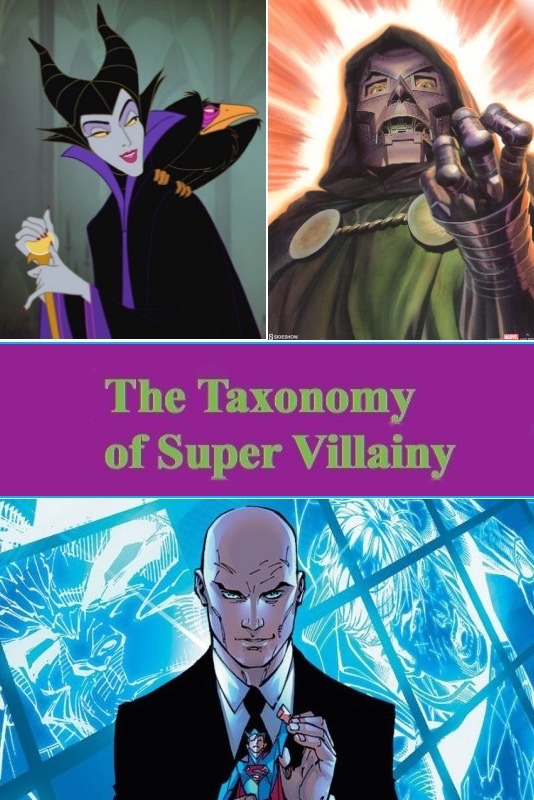
Introduction
There are many, many super villains in the realms of fiction, comic books, cartoons and movies. When encountering such villains, these costumed cads and dangerous dastards, it is of the utmost importance that one know the precise type of malefactor is at hand. While no two villains are exactly alike, as a whole these scoundrels can be roughly categorized into a systemic taxonomy; a classification based upon the qualities of threat, capability and ambition.
This taxonomy is sequential in respect to the level of danger, commitment and aspiration. It begins at a first rung with the lowly Goons, moving quickly to the dangerous Enforcers, then the mercurial Rogues, followed by the calculating Lieutenants and finally the Nemeses… the most dangerous villains of them all.
Goons
First let us look at the Goons. These are the minions, the henchmen and stooges who use their powers to do the bidding of a more sinister and scheming master.
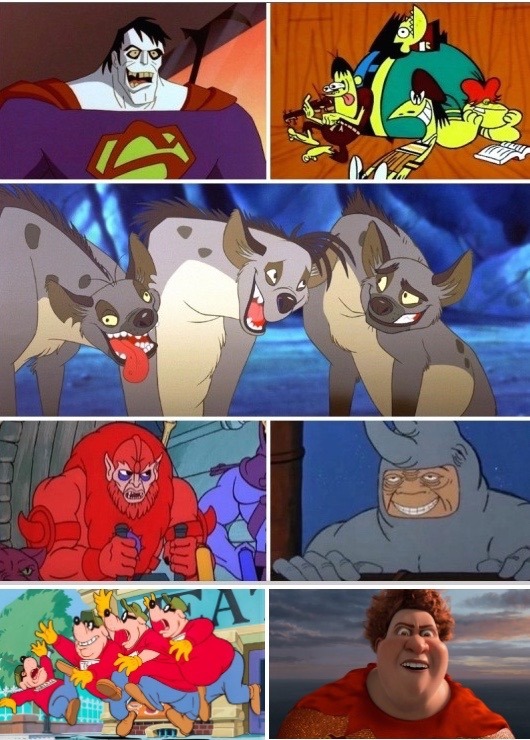
Goons can be quite formidable, possessing a great deal of raw strength and power. Yet their lack of foresight, aspiration and direction leave them in the position of playing the role of pawns.
Whether it be the result of laziness, naïveté, psychological difficulty or some manner of deficiency, Goons are easily manipulated. They are frequently duped or cajoled into doing the bidding of others. Sometimes they will perceive themselves as being equals with those they serve. In truth, however, these misguided flunkies are almost always viewed as disposable... as mere vassals who will be sacrificed or simply discarded on a whim.
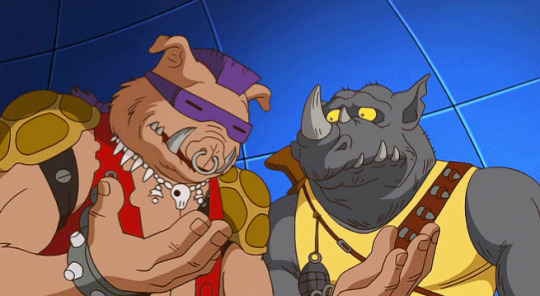
Criminal organizations will frequently have numerous henchmen who are nameless and interchangeable. What distinguishes a super villain Goon from the more garden variety lackey is their physical power and capacity for destruction. They possess all the raw ability to be a more substantial menace but none of the imagination, presentation or drive. They simply lack the je ne sais quoi needed to be a more fully actualized embodiment of super villainy.
And yet this does not make the Goon any less dangerous. Indeed the Goon’s fragile ego coupled with their destructive capability can lead to threats on par with a natural disaster.
Conversely, the Goon can sometimes be the most likely type of super villain to be turned, moved toward the path of heroism. Most Goons just want to be seen and valued, to garner a place where they feel they belong. More sophisticated villains will take advantage of this unmet need, offering the Goon a sense of purpose. If a hero can convince a Goon that they are being manipulated and offer a more authentic sense of validation, the goon may very well switch sides and become heroic.
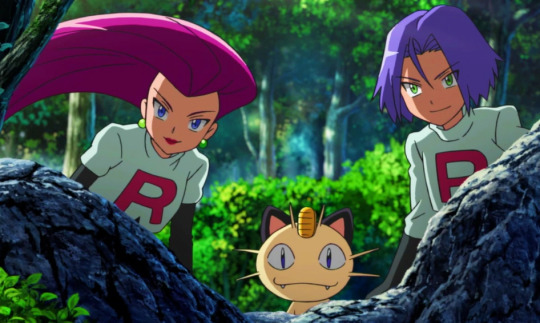
For the most part, however, Goons are rather satisfied with their lot. They are often simple souls with simple needs. Being a Goon affords a sense of direction and license to be destructive bullies.
The Enforcers
When the raw power of a super villain Goon is coupled with a heightened degree of shrewdness, confidence, avarice and capability, the end product is often The Enforcer.

These are the mercenaries, assassins and bounty hunters… the guns-for-hire who are brought in for a specific task (commonly the elimination of a hero). These villains are not interested in taking over the world, garnering power and influence, they just want to get paid.

Said payment is most often money... but prestige, thrills and a bolstering of one’s ego are also a commonly accepted currency. Sometimes Enforcers will be pitted against a specific hero and the simple opportunity to best that hero, to show themselves as the superior entity, is motivation enough to take on the job. They can be like big game hunters, in desperate search of a new and bigger trophy to add to their ever-growing collection.
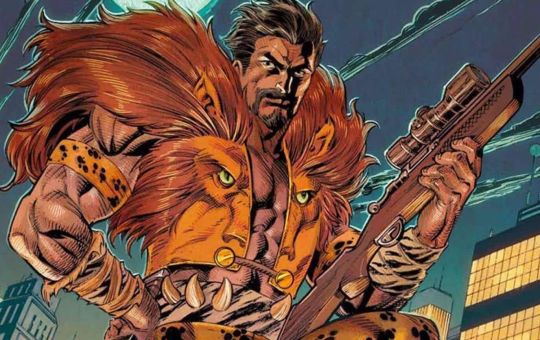
Some enforcers may be motivated by mere boredom. They tend to be thrill-seekers and super villainy is an irresistible rollercoaster that acts to quell the tedium. It is not uncommon for there to be a degree of sadism to the enforcer... even psychopathy. Their passion is doling out pain and destruction; they revel in being feared. They are dangerous and unpredictable and will endeavor to succeed at any and all costs. They are not to be taken lightly.

It is not unheard of for Enforcers to have underlings of their own, aides or minions who will assist in their schemes. Or they may work in conjunction with Goons. Yet their values are strictly mercenary. Their morals and philosophy are entirely for hire. Some Enforcers may adhere to their own, personalized code of conduct... yet it is a strictly idiosyncratic (and often malleable) matter.
Phrased simply, they are not individuals to be trusted; an Enforcer will turn on their employer the moment that it better suits their interests. Beware, my friends, Enforcers are danger incarnate...
Rogues
Rogues are outsiders, individuals who just do not fit in with the common and traditional conventionalities of a given society. They are misfits, freaks, square pegs in a world of round holes. Yet they also have power; they are capable, smart, ruthless and shrewd. They do not fit in, but they do not need to; they can force their worlds to accommodate to them.
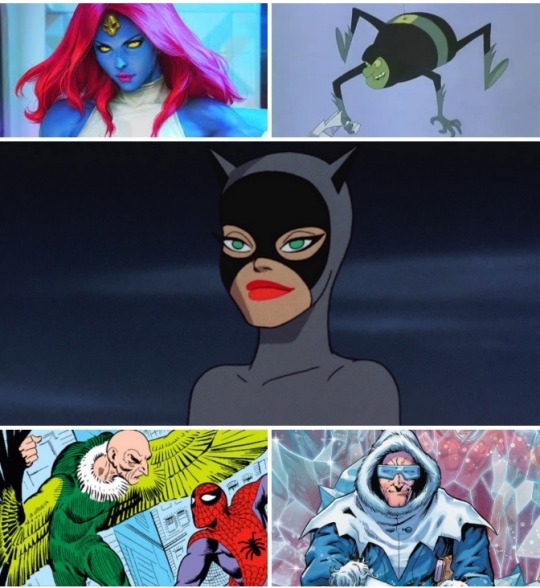
Rogues are outlaws. They take what they want when they want it. Rarely is there an overarching agenda. Rogues do not crave power, they do not want to rule the world. They just enjoy a good time, desire the finer things and will take all that they feel they are owed.
Many factors can go into the making of a Rogue. Circumstances of their upbringing, their appearance, deprivations of different kinds, accidents… all maters that have put the Rogue in a place of alienation from society writ large. In some regards they are victims, perhaps not always innocent victims, but victims nonetheless… and victims with agency. For they have power and the capability to extract whatever vengeance or retribution they feel they deserve.
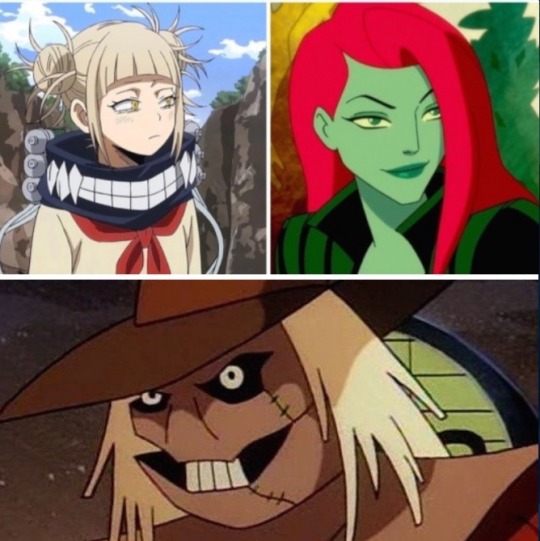
Not all Rogues are victims of misfortune. Some merely possess a sense of entitlement and a desire for adventure. Morality, for better or worse, is just not a central feature in the make up of the Rouge. They see the world around them as a harsh and unforgiving realm and they will take what they want, do as they please, simply because they can. They are not motivated by hate, avarice nor a diminished sense of self esteem. They are supremely independent and the needs, feelings and wellbeing of others are not matters of any great concern.
The super villain Rogue has much in common with the archetype of the Trickster from myths and fable. Tricksters are breakers of boundaries who enjoy disrupting societal principles and norms. These are often supernatural beings whose playful antics act to mock authority and question assumption. Rogues are similar. They too seek to disrupt authority, upset balance and turn social decorum unto its head.
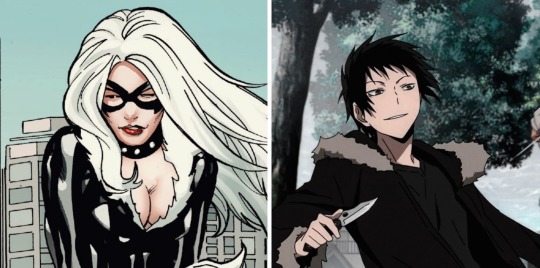
Whereas many Tricksters of lore aim to teach lessons regarding the hubris of mankind, Rogues tend to be much more self-serving in their conduct. Rogues are not agents of chaos, they just want to express their freedom and garner wealth and renown.
While Rogues often prefer to work on their own, they are by no means entirely above joining forces with other villains in working toward a mutually desired goal. Although it is rare, a Rogue may even allow themselves to be employed by a Nemesis, a more diabolical cad whose overarching desires very much do not align with their own. In these situations, the Rogue’s hand is either forced or they are simply biding their time for the ideal opportunity to engaged a well-planned and self-serving betrayal.
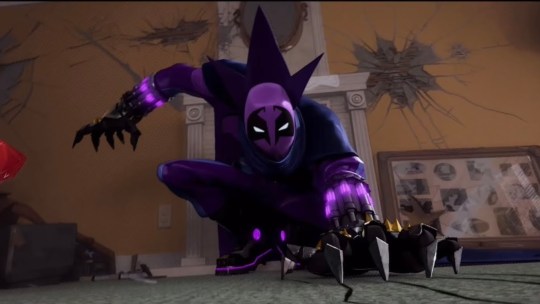
It is the Rogue’s refusal to adhere to societal principles and the law that often brings them into conflict with heroes. And the sympathetic qualities of the Rogue can sometimes cause a hero to question their own beliefs and moral alignment. The Rogue represents a defiance toward the status quo of a given society... that existing state of affairs that maintains social and financial stratification. The status quo is never an entirely fair system, it will always benefit some at the expense of others,...and it can be tempting to forcefully push back against the inequities that exist therein. Indeed there have been many a hero who has fallen under the sway of a charismatic Rogue when made to see said inequities.

And yet Rogues tend to be quite selfish. They have been wronged and use it as an excuse to do whatever they please and put their own needs above all others. In so doing they may end up hurting others in the same fashion they themselves had been hurt. These Rogue could be heroes, yet frequently lack the sense of selflessness that truly makes a hero heroic.
Under the right circumstances, however, the Rogue can find themselves in the role of the antihero... acting as a protagonist despite lacking the traditional qualities most often associated with heroism. This is most often the case when the Rogue’s goals put them into opposition with another villain, particularly a villain much more vile than themselves.

Although some Rogues may fit into the role of an antihero, it does not necessarily make them any less dangerous. The primary characteristic of a Rogue is a rejection of the normative confines of a society. And this can include the confines of morality. The Rogue will resort to murder and mayhem if they deem it a necessity. So beware, my friends, beware.
The Lieutenants
In some regards, Lieutenants are the villainous analog to the hero’s sidekick. They are the primary right-hand operatives of the arch villain… an amalgamation of a partner, field commander, conciliary and moll. They are neither a Nemesis nor a Goon, but something in between.
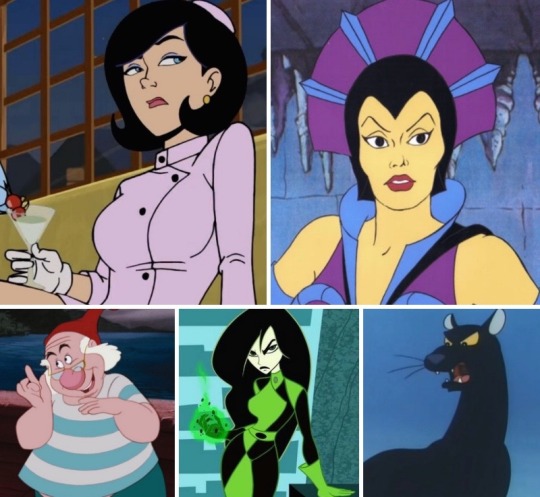
Quite often the Lieutenant will be a good deal more competent, pragmatic and even more intelligent compared to the villain they serve. They could easily be a leader in their own right, yet lack the megalomania that is at the heart of a true Nemesis. What these lieutenants do possess, however, is a deeply seated need to belong... to have a parental-like figure that offers direction and purpose. Some even love the villains they serve and remain at their side for this reason alone.
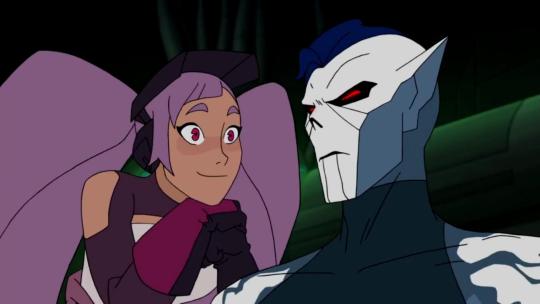
Lieutenants crave power and respect, they feel a poignant need for validation and this will often lead them to battle against the heroes with vigorous intensity. They can be the most dangerous kind of villain of them all in that they are highly motivated and intelligent as well as desperate to succeed; almost like a child who will do anything to win the approval of a parent.
The neurotic nature of the Lieutenant’s motivation frequently leaves them a good deal less sadistic and malevolent compared to the Nemeses they serve. They are not bloodthirsty or callous; many may even have care for the innocent lives that a dastardly plot might harm. And yet the need for approval acts to outweigh any moral qualms they may possess. That being said, it is not entirely unheard of that a Lieutenant will turn on their leader if the destructive stakes become far too high.
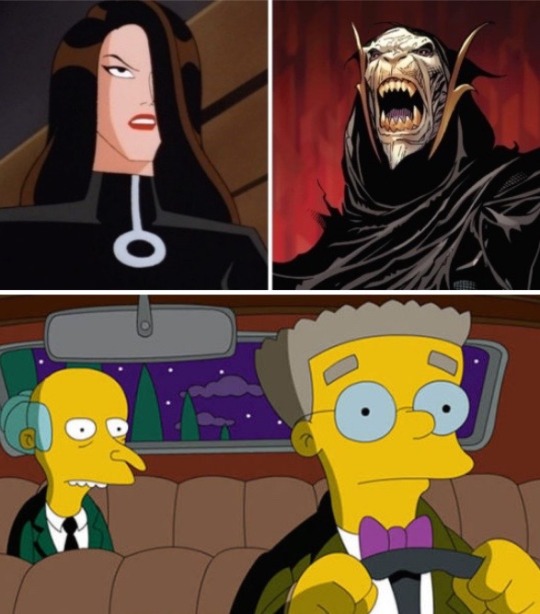
Somewhat akin to the Goon (or even the Rogue), the Lieutenant possesses the potential to turn to the side of good, to be redeemed and become something of a hero. The Lieutenant is highly capable and shrewd, but not above manipulation. Often times they will find themselves in the service of a master who does not have their best interests in mind.
Discovering that they are not as valued by their leader as they may have thought can help the Lieutenant rediscover their sense of honor... a clearer picture of right and wrong. Herein there becomes an increased likelihood that the Lieutenant will turn and aide the heroes... possibly even become a hero themselves.
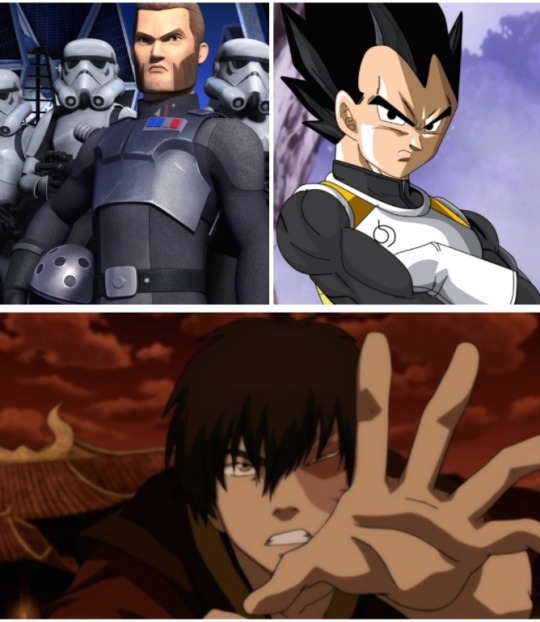
Of course this is not to say that every Lieutenant possesses a staunch code of honor or secret heart of gold. Some are just as rotten and despicable as the cads they serve. They have pled fidelity to their masters and many see the orders they have been issued as on par with a godly and righteous decree.
At the same time that many Lieutenants are unquestioningly loyal, others can be duplicitous. Again, it is not uncommon that a Lieutenant will actually be more competent compared to those they serve. And some possess the ambition to usurp their masters, concocting fiendish schemes to depose their leader, take control and ostensively matriculate to the position of the Nemesis.
This particular dynamic is quite often at play with the ‘secret lieutenant.’ This is something of a subcategory reserved for those second-in-commands who are initially believed to be the primary villain… only for it to be later revealed that there is an entity even more diabolical above them.
Nemeses often cherish their anonymity, preferring to remain a more secretive threat from behind the proverbial curtain. To this extent they need a Lieutenant to stand in as their vassal. It is not uncommon for these proxies to be misidentified as the primary Nemesis. And more often than not, these secret Lieutenants become accustomed to the power they wield... harboring resentment toward the shadowy overlords that they secretly serve. Sometimes they will take action to achieve their ambitions… yet it rarely works in their favor and a Lieutenant’s efforts to usurp their masters will frequently have deadly consequences.
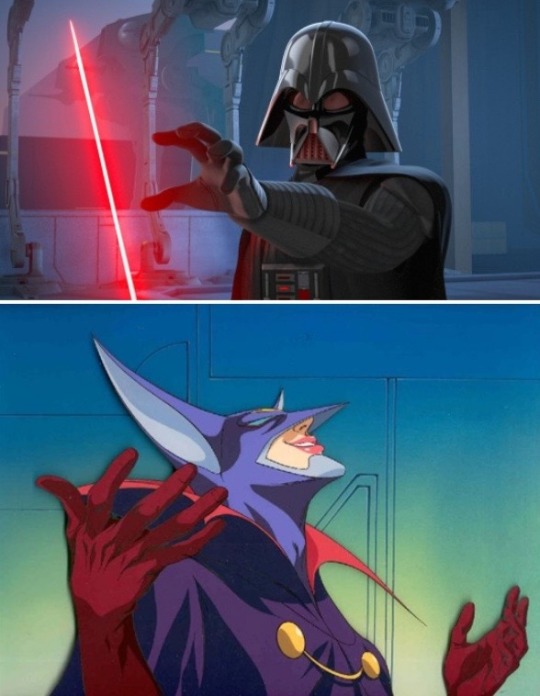
There are reasons after all, that Lieutenants and Lieutenants and Nemeses are Nemeses. The qualities that make for a true Nemesis are as insidious as they are dangerous. They are not so easily overtaken nor replaced.
Nemeses
This brings us to the are the baddest of the bad… the arch foes, the megalomaniacal would-be conquerers whose devilish schemes put us all in grave peril. The pinnacle of villainy; the foil to all things good, selfless, noble and heroic. The Nemesis!
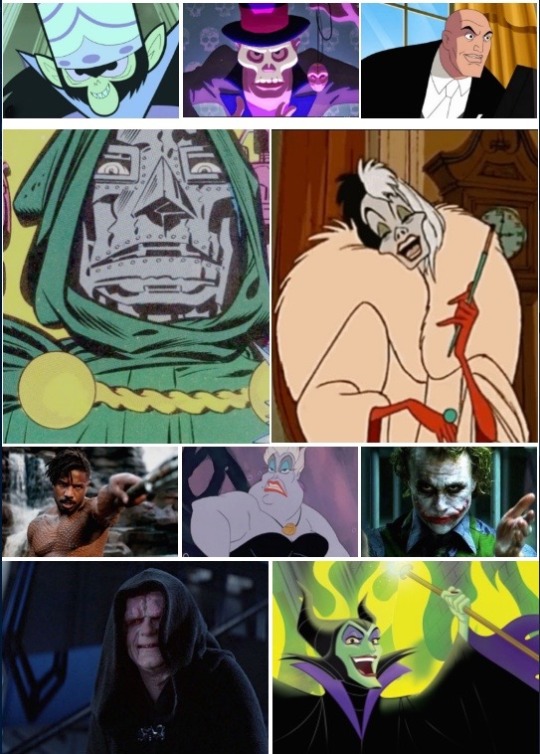
The primary feature to the Nemesis is their motivation. They have a keen notion of how things should be and will stop at nothing toward imposing their will so to bring their goals to fruition. Such goals may be power, conquest, revenge or the acquisition of fabulous wealth (or all of the above). Regardless, the Nemesis believes that fulfilling this goal is a righteous purpose, that it is a destiny ordained unto them by some manner of a divine source.
Most Nemeses do not see themselves as evil. They are the heroes of their own stories and believe themselves to be in the right. Furthermore, any who oppose them represent an effrontery that need be eliminated with extreme prejudice. Theirs is a glorious purpose and nothing nor no one may be allowed to obstruct their destiny.

With such lofty ambitions, it is frequently necessary for these Nemeses to create elaborate organizations… secret and sinister syndicates composed of various operatives, agents, minions and flunkies. The Nemesis can be extremely charismatic ideologues and they usually have little difficulty in recruiting scores of cronies and henchmen willing to lay down their lives in the service of a master. Whist some Nemeses have to resort to paying their underlings or at least putting forth the promise that the toiling will result in power and riches, most are simply able to amass a loyal following through their magnetic charm alone.

The true qualities of the Nemesis often comes into greater focus in juxtaposition to their arch enemy. The primary foe of the Nemesis acts to define them, highlighting their traits in contrast to their opposite. The more good and pure the hero the more twisted and evil their nemesis. One acts to complete the other like two sides of a scale equally balanced.
Indeed it is not unusual for a Nemesis to become obsessed with their arch foe... so much so that many Nemeses may even hesitate at the opportunity to finally vanquish said foe. They can come to feel actualized by the conflict and may fear a loss of identity were their enemy to be truly eliminated.
Many heroes will have multiple arch enemies, but Nemeses themselves are more exclusive, monogamous in who they see as their principle foe. Furthermore, they can be quite jealous when it comes to the attention of their arch enemies. So much so that it is not unheard of for a Nemesis to lend a hand to their foe in doing away with a third party interloper.
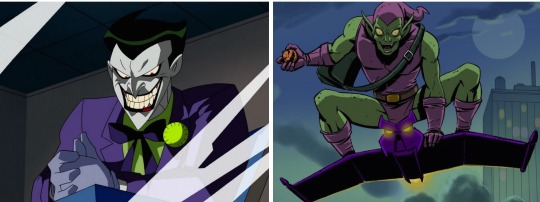
Not every Nemesis is cut from the same cloth. Some can be mere mustache-twirlers… finks who commit evil deeds for the mere sake of it. The more memorable and fully actualized Nemesis, however, is complex and nuanced. There is an element of the inscrutable that can provoke fascination. They are like elaborately colored serpents who elicit equal measures of fear and curiosity.
Despite their despicable acts, the Nemesis can frequently be found to be a rather sympathetic figure. Similar to the Rogue, the Nemesis is rejecting of the societal status quo. They believe they know better, that imposing their will can bring about much needed change. Considering the various inequities and injustices entailed in any society, the promise of change can be very alluring. Tearing something down is always easier than creating something new; and the Nemesis excels at the former whilst offering mere promises of the latter.
Add to this the flamboyant charm and sleek aesthetics of so many super villains and it can all come across as quite alluring. And this attraction can be greatly magnified in those feeling even the least bit alienated by the confines and restrictions of a societal equilibrium.
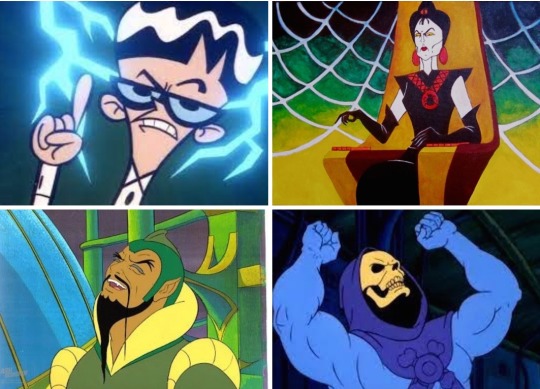
Most all Nemeses are idealists. Their ideals are twisted and egocentric, but they are idealists nonetheless. In their heart of hearts, these cads honestly believe that the imposition of their self-serving values will bring about their notion of a better world. Even the ones who claim to be nihilists, who say they just want to see the world burn, harbor the desire to harness power and refashion it all in the cast of their megalomania.
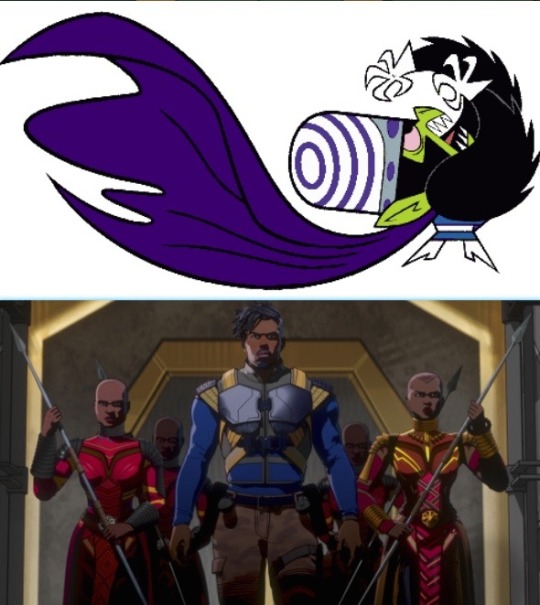
The Nemesis is an enjoyable character only to the extent that they do not win, that their schemes remain unfulfilled. And if said plot is at least partially accomplished, the fun part is their histrionic efforts to put down resistance and maintain their tenuous grip on power.
Conversely, Nemeses who too closely parrot real life horrors become unenjoyable entities for the audience. There are plenty of villains who are racists, who commit sexual assault and/or who adhere to repugnant philosophies. These baddies do not fully qualify as super villains. They are just regular villains. Super villains, like superheroes, are figures of fantasy... they are meant to be fun. A true super villain, a real nemesis, may toe the line of real-life horror but should not overstep it.
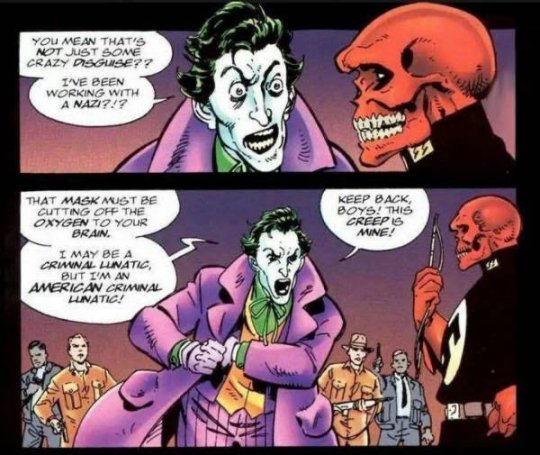
Not all Nemeses pose the same level of peril. The Nemesis covets a world bent to their whim, yet not all possess the faculties needed to constitute a true threat. Many nemeses are capable, shrewd and cunning; whilst others can be plagued by hubris, myopathy and just plain incompetence. And others still can demonstrate great prowess in one instance and then great blundering in the next. The same passion and unwavering drive that fuels the Nemesis can also lead them to make costly, foolhardy decisions. Nevertheless, a buffoonish villain can be just as captivating and fun as one who is sophisticated and poised.
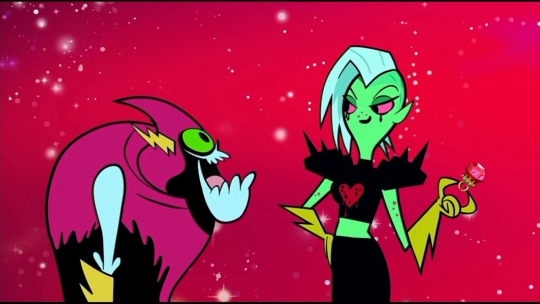
Of course any summation of the Nemesis, or super villains in general, would be incomplete without addressing the matter of how frequently villainous characters have been used in stories as thinly veiled stand-ins for the queer community.
This is done through a kind of coding… subtle and not-so-subtle hints that the villain is something other than heterosexual. Male villains are often presented as effeminate or flamboyant, female villains as masculine and butch. This is meant to have the effect of making the Nemesis appear more deviant and dangerous. As well as make their ultimate defeat by the hero somehow more satisfying, reinforcing the erroneous notion that being queer is in some way morally wrong.
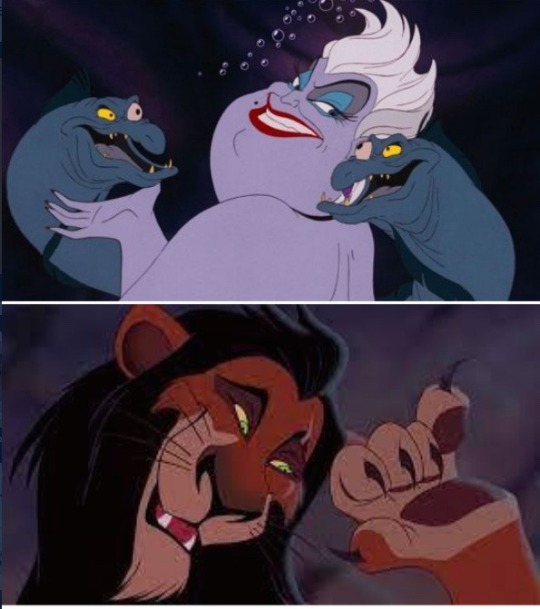
This queer-coding of the villain is not always consciously intended to be homophobic/heterosexist, but it often has that effect; and perpetuates harmful stereotypes about the LGBTQ+ community that can lead to real-world discrimination and violence.
There can be a strange and entirely artificial conversion of machiavellian manipulation and the disrupting of traditional notions of gender. This is the idea that those who are transgender, women who act masculine or men who act feminine, are somehow engaging in a sinister chicanery. That they are temping and coercing the innocent and vulnerable into embracing deviancy.
This is not the only way in which the Nemesis has been used as a means to present social-political agendas. Near countless forms of bigotry and prejudice have been repackaged in the form of a sinister Nemesis. The ‘yellow peril’ style villain depict people of Asian descent as cold, calculating and soulless; whereas the savage ‘witchdoctor warlord’ presents Black and Brown people as primitive, superstitious and godless; and the hook-nosed ‘miserly masterminds’ puts forward Jewish people as conniving, greedy and unscrupulous.
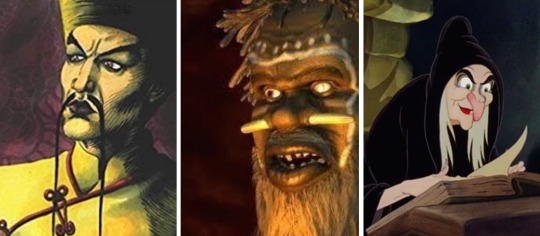
Ironically, as time has gone by, this politicizing of the villain has only acted to make the Nemesis even more intriguing and appealing. In that the Nemesis embodies all that is debaucherous, forbidden and deviant, the hero becomes more and more forced into role of the foil. The hero must be pious, chased and entirely pure of heart. They become flawless and such perfection in the realm of fantasy and wish-fulfillment is rather boring. As the hero becomes more two-dimensional and un-relatable so too is their arch Nemesis made more alluring and empathetic.

Indeed this has led to heroes gradually become more like villains in an effort to keep them interesting. The sterling white hat of the traditional hero has been traded in for something a slightly grittier shade of gray. Heroes have become more grim and steely, brooding neurotics fueled by past trauma. This may seem like standard fare in the here and now, but it is a base dynamic heavily borrowed from the villainous Nemesis. ...imitation, as they say, is the most since form of flattery.
Thus concludes our brief summation of villainous taxonomy. Does every super villain fit perfectly into one of these five categories? Likely not… but as close a fit as necessary. And certainly there can be movement between the levels: Goons who matriculate to Enforcers, Rouges who go on to become Nemeses. By and large, however, these are fixed positions and most all super villains can be seen as occupying one of these taxonomical genres.
186 notes
·
View notes
Note
Hey there!! I hope this question isn't too morbid, but im writing a story where prisoners are often sold to this circus who puts on shows for aristocrats/basically anyone else who can afford it but the prisoners are like....literally torturing each other and being tortured for entertainment. I've never really been someone whos into horror/thrillers, so im not sure where to look to research it. I was wondering if you had any suggestions for performances which would be morbidly entertaining for a fucked up audience, but also lethal and deadly for the "entertainers" themselves? (Or if it'd be easier to suggest media to research this type of topic, i'd love that as well!)
Thank you so much, i love your blog!!
Writing Notes: Dangerous Performances
Hi! You could draw inspiration from dangerous types of performances throughout history, some of which were for the entertainment of the ruling class. You can consider altering them to better fit your story. Here are some examples I found for you:
Though many ancient Romans lived very hard lives, there were still plenty of options for entertainment. This ranged from music and theatre to more bloody past times like the gladiator arena.
One of the famous figures associated with ancient Rome was the gladiator. The image of brawny warriors battling to death in gigantic marble amphitheaters for the amusement of a rabidly cheering crowd was indeed powerful.
The Roman Arena was a place of entertainment for Romans. The games were often brutal and bloody. At first they were mostly put on for memorials or funerals, but later they were put on for many occasions including birthdays and victories. The games were paid for by wealthy individuals and were used for that person to gain popularity with the people. Julius Caesar became very popular by putting on large public games and theatre.
Animals in the Arena: Sometimes the games would last all day. At the start of the day they would use exotic wild animals such as bears, lions, rhinos and elephants. Sometimes the animals would fight each other, sometimes the animals would be hunted by huntsmen, and sometimes criminals would be thrown into the arena to be killed by wild animals.
The ordered beauty of the Colosseum is in stark contrast to the murderous encounters that took place within it. Bloody Spectacles at Ancient Rome’s Colosseum:
Staged Naval Battles
Exotic Animal Fights
Forest Hunting
Human Executions
Gladiator Battles
Roman boxing. Far different than the boxing developed by the Greeks, was considered more of a gladiatorial show than an athletic contest. While the crowds were smaller than at the amphitheater and circus, boxing was an important part of public entertainment. Unlike Greek boxers, who wore leather thongs around their knuckles for protection and performed for prizes at the prestigious Panhellenic games, Romans used gloves with pieces of metal placed around the knuckles (caestus) to inflict the most damage possible. Moreover, there was no time limit or weight classification. Proclaiming a winner resulted from either a knockout or the conceding of defeat by one of the boxers.
The oldest games in Rome were the chariot races. Typical chariots used for the races were drawn by a team of four horses (quadriga). The races required two long tracks and two 180-degree turns. Like gladiatorial shows and boxing, races were extremely dangerous, since chariots often collided or went out of control. If a driver fell out of his chariot, he could easily be dragged along or trampled to death by the horses. Nevertheless, there was no shortage of drivers, as eager young charioteers risked their lives for reward and recognition.
Spectacle was an integral part of life in the Roman world. Some forms of spectacle—triumphal processions, aristocratic funerals, and public banquets, for example—took as their backdrop the city itself.
Others were held in purpose-built spectator buildings: theatres for plays and other scenic entertainment, amphitheaters for gladiatorial combats and wild beast shows, stadia for athletic competitions, and circuses for chariot races. As a whole, this pervasive culture of spectacle served both as a vehicle for self-advertisement by the sociopolitical elite and as a means of reinforcing the shared values and institutions of the entire community.
“In the end, the games were about othering people and dehumanizing them,” Nathan Elkins says, deputy director of the American Numismatic Society. “It was about watching and enjoying somebody else suffer because Romans felt they were better and more privileged.”
Thanks to their favoured position in life and the labour of the peasants on their estates, nobles in an English medieval castle had plenty of leisure hours.
Tournaments
Gave knights the chance to hone their skills with horses and weapons in a relatively safe and controlled environment, although there could be injuries and fatalities despite the precautions.
The competitions took two formats, either a mêlée, which was a mock cavalry battle where knights had to capture each other for a ransom or the joust where a single rider armed with a lance charged at an opponent who was similarly armed.
To minimise the risk of injury, weapons were adapted such as the fitting of a three-pointed head to the lance in order to reduce the impact and swords were blunted (rebated). Such weapons became known as 'arms of courtesy' or à plaisance.
The popular Round Table tournaments involved knights dressing up as characters from the legends of King Arthur who then jousted and feasted in costume.
Watched by an audience which included the local aristocratic ladies, motivation to perform and display chivalry was high.
There were also prizes such as a gold crown, jewels, or a prized hawk so that many knights made a living doing a tour of tournament events across Europe.
Even if a local tournament was not perhaps a regular event, one could at least practice for them.
A common device to hone one's lancing skills was the quintain - a rotating arm with a shield at one end and a weight at the other. A knight had to hit the shield and keep riding on to avoid being hit in the back by the weight as it swung around.
Another device was a suspended ring which the knight had to catch and remove with the tip of his lance.
Sources: 1 2 3 4 5 6 ⚜ More: Writing Notes & References
Previous posts you might find useful: Horror ⚜ Psychological Thriller ⚜ Book Genres
#anonymous#writing reference#writeblr#dark academia#spilled ink#literature#writers on tumblr#writing prompt#writing inspiration#history#writing ideas#creative writing#writing resources
52 notes
·
View notes
Text
Arden Morvant



Behavioral Analysis Unit
Confidential Psychological Profile
Subject: Arden Morvant
Prepared by: Dr. Spencer Reid
Date: [REDACTED]
Classification: Former Peripheral Offender / Probationary BAU Profiler
OVERVIEW:
Arden Morvant is an anomalous profile in the BAU, an outlier in both origin and trajectory. He possesses the rare duality of someone capable of immense psychological harm yet drawn magnetically toward healing. He is not a sadist. He is not devoid of empathy. But he is someone who understands violence, too well, too intuitively; that understanding was once misused. Often unknowingly, sometimes deliberately.
Morvant didn’t kill. He didn’t mutilate. He didn’t even touch the bodies. But he set the stage, sometimes literally. He gave monsters their scripts. And when they acted, he watched.
He helped unsubs the way a composer writes music for someone else’s ballet. He never performed it. But he knew exactly how it would look.
EARLY DEVELOPMENT:
Morvant’s formative years are defined by neglect, both emotional and structural. There is no evidence of overt abuse, but neglect, particularly chronic emotional neglect, is a form of trauma that often yields either one of two outcomes: internalized shame and dissociation, or externalized control-seeking behavior. Morvant developed both.
He learned early to make himself invisible when necessary, charming when required, and useful above all else. This led to his long pattern of involvement with predators who recognized his genius and lack of boundaries, and exploited both. He wasn’t coerced. He wasn’t entirely complicit either. He drifted, and then he directed.
PERSONALITY STRUCTURE:
Morvant is a paradox. He is both self-aware and self-obscured. He knows what he is. But he doesn’t always know why. He is governed by a deep need for structure, but has a volatile emotional core beneath it that manifests in ritualistic behaviors:
• Mirror shards: Morvant keeps them on his desk—not for vanity, but to “reflect his thoughts.” It is likely a compulsive grounding tool—fractured reflections mirroring a fractured identity. There’s symbolism in it. The man who helped unsubs see themselves never really saw himself clearly.
• Violin playing: Much like my own use of chess or quantum algorithms to process complex emotion, Morvant uses the violin to regulate his affective state. He plays not to perform but to process. I’ve observed him use vibrato patterns to calm himself and harmonic tension as a substitute for verbal communication. It’s not music. It’s Morse code with strings.
He lives almost entirely inside his own mind—a dangerous thing for someone whose mind once built mazes for killers. But within the BAU, structure is externally imposed, and for the first time, Morvant wants that.
ATTACHMENT & RELATIONAL DYNAMICS:
Morvant has latched onto Unit Chief Aaron Hotchner with a fervent emotional fixation. It is gravitational. Hotch is a constant, a walking anchor, and Morvant orbits him like a lost satellite hoping not to burn up.
Possibly past relationship.
He mirrors Hotch’s posture. Matches his cadence. Defers in a way that borders on childlike loyalty. It’s a classic anxious-preoccupied attachment with clear roots in early deprivation.
His dynamic with me is different. I think he sees me less as an anchor and more as a lighthouse. He shows me his worst thoughts. His weirdest ones. He trusts that I won’t flinch. That I understand—because in many ways, I do.
CLINICAL CONCERNS:
Risk Indicators:
• Prone to obsessive fixation (cases, people, ideas)
• Tends toward dissociation under emotional stress
• Struggles to define a consistent moral compass—especially when someone he cares about is in danger
• Will manipulate for security, not out of malice, but survival instinct
Protective Traits:
• Deep remorse, even when expressed obliquely
• Profound loyalty to those he deems safe
• Highly creative, non-linear problem solver
• Appears to thrive under authority when it’s paired with emotional consistency
MORALITY & MOTIVATION:
Morvant is not evil. He’s untethered. Or rather—was. Now, he’s trying to rebuild a moral foundation that was never given to him. It’s slow. Messy. Painful. But it’s real. He wants to be useful again. But now for the right reasons.
He clings to symbols: mirrors, music, outlines of order, because they keep the chaos at bay. And if you asked him directly, I don’t think he could tell you what scares him more:
Being who he was.
Or being someone no one understands.
FINAL SUMMARY:
He’s dangerous. But not to us.
He’s unpredictable. But never maliciously so.
He’s brilliant. But he knows that already.
What he doesn’t know yet, is that he’s redeemable.
And I think, with time, and trust, he’ll prove that to the rest of the world too.
He already has to me.
—Dr. Spencer Reid
#criminal minds#criminal minds au#profiling but make it personal#arden morvant#male oc#aaron hotchner love interest#spencer reid#criminal minds fandom#daniel bruhl face claim#daniel bruhl oc#daniel brühl
14 notes
·
View notes
Note
hi!

for the drabble can you do anything with snowbugs? :)
Ok... Listen... I know it has been over a month. I am so sorry. I got distracted. I hope that you accept these 1.8k words that I wrote as an apology.
Anyways, it's technically not snowbugs yet... But they are totally endgame, it will happen. Also feel free to imagine whoever you want as the fellow heroes and villains. I didn't really bother distinguishing them... Whoops
-
Scott’s hands shook, his breath shuttered in his chest, his blood roared in his ears, power pulled tight around his throat like a noose, his mind was racing.
It was too much. It was too soon. He’d told them it was too soon, that he wasn’t ready, and yet here he was.
“Pull back!” He heard the call of his squad captain, “He’s too dangerous!”
Scott shuttered, another wave of cold power pulsed through the warehouse they had been fighting in as he tried desperately to contain it.
He hated this.
You see, Scott was still new to this whole powers thing. For most of his life he, and everyone else around him, had assumed Scott didn’t have powers. Not exactly an uncommon occurrence in their world, though you were still more likely to end up with something mundane than nothing at all, however, so it was ever so slightly disappointing when he passed milestone after milestone without tried or trace of any sort of power. By the time he reached adult hood, he figured that was it. Developing a power after eighteen was uncommon enough, but a major one - that was practically unheard of.
Scott was 28 when he developed the ability to completely freeze anything with little more than the flick of his hand.
He had reported the development immediately to the government, as the had a mandated training program for people with powers above a certain level classification. He had gone in expecting to be trained on control, to learn how to go about his normal day again and leave. The more intensive hero program that was designed to allow individuals the ability to help fight against rogue power users was - as far as everyone was told - entirely voluntary, and Scott and no desire to do anything but return to his normal life.
He found out the hard way that voluntary had a much looser definition when a power is considered too strong or in particular demand. Sure, he had the choice to forego the program, but he would have been marked a rogue and likely sent to prison, so he agreed, and Smajor was born.
They fast tracked him through the program, skipping the basics and barely letting him get a grasp on how to marginally reign in the cold beyond focusing and keeping calm before thrusting him out into combat training.
It hadn’t been the worst, Scott had been learning how to focus his powers in calm environments and it had been going well, so long as he had no distractions.
Then they got the call that Tek was out with some other villains, causing problems, and Scott was sent out with a team to deal with him specifically.
Tek was, for all intents and purposes, the reason Scott didn’t get a say in joining the hero program. Strong elemental powers like his ice were rare, which while likely would have subjected him to pressures to join, Tek had his opposite in fire and they had no heroes with strong enough powers to go against it. At least until now.
Scott tried to protest, to tell his handler - and how he loathed that title - that he wasn’t ready for that level of fight. Hell, Scott was pretty well certain he wasn’t ready for team training exercises yet, but it didn’t matter in the eyes of the higher ups.
“Sometimes it’s sink or swim, kid,” He was told, “When the time comes, you’ll know what to do.”
Protests that he was going to sink going unanswered as he was stuffed into a far too regal looking blue and while suit, gold accents only calling more attention to him, and pushed front and center as other members of his team squared off and distracted other villains, until it was just Scott staring at Tek with barely hidden fear, and Tek returning the stare with bemused confusion.
Scott couldn’t breath as the noise around them grew. He knew what he should be doing, he knew that people were counting on him, but all he could focus on was the ever growing sense of terror as he stared at the flames that casually danced along Tek.
How was he supposed to fight him? The casual confidence of a man who had years to master his power verse the maybe six months Scott had had to do the same.
Everyone was relying on Scott, and he was going to fail.
He watched the bemusement slip from Tek’s face, turning to genuine confusion, realization, then - oddly enough - nervousness. He had opened his mouth to speak, but Scott made out none of what he said through the blood rushing in his ears. It wasn’t until he heard a curse from one of his teammates that he realized that a sheet of ice had been snaking out along the ground around him, small spikes of ice budding up in places without say.
“Dammit Smajor,” The angry tone broke through his revelry, “Focus! Them, not us!”
The words just make things worse, anxiety spiking, pulsing cold echoing the beating of his heart as it matched the frantic pace. Scott did his best to pull the powers back, trying to focus on breathing as several eyes turned towards him, tried to ignore the expectations piling on him.
“What the hell do you idiots think you’re doing?” Scott heard one of the villains ask, “Sending out a kid this green when he can barely keep a grasp on his own powers?”
Scott wants to laugh. Hadn’t he been asking the exact same thing? He pulled his arms across his body as if he can physically hold his powers in. All it does is cause ice to grow across his torso as he sinks to his knees. The ice seems to get worse, a small snow flurry begins, building rapidly inside the tiny warehouse.
Why can’t he just breath?
“Pull back, he’s too dangerous” The call is made and the bubble of laughter finally breaks through.
‘So much for avoiding jail time after this shit show,’ He thinks bitterly, laughter quickly turning to sobs. He just wanted to go home.
He distantly hears the sound of movement, can feel the disturbances against his ices as several people move to exit or take cover from the ticking time bomb Scott has become. He can hear the sound of heroes and villains alike arguing about him.
Oddly enough it sounds like the villains are the ones on his side, somehow.
In the midst of this, he is surprised by a warm hand on his shoulder. He flinches back, another wave of power emanates from him and he desperately tries to pull it in, focus it on himself as his looks up, meeting Tek’s eyes through his mask. Warmth and compassion shine through. He seems unaffected by Scott’s powers, any ice that gets near him melting. He doesn’t even shiver.
Scott envy’s him for a moment.
“Hey, Smajor was it?” He asks, casual as can be, as if Scott wasn’t actively turning the room into a walk in freezer. The absurdity of it gives Scott pause for a moment, and he finds himself nodding, “Nice to meet you, I’m Tek.”
“I- I know that,” Scott replies, confused, “I think most people know that.”
Tek smiles at him, and it’s so bright and warm that Scott wants to lean into it, to keep it there.
“I suppose the costumes a pretty big give away, isn’t it?” There is something soothing to his voice that calms Scott down some. The noose around his throat loosens, the next wave of power seems softer, “I can’t imagine that feels all to great.”
Tek gestures to where Scott’s hands are wrapped around himself, the shards of ice pressing into his sides, the tears in his own costumes it has made, “Do you want to maybe move your hands?”
He makes an aborted move to talk to hands but Scott pulls back some, hangs clenching tighter, causing him to flinch yet again.
“I can’t,” He admits, “I don’t- I don’t want to hurt anyone.”
Tek’s eyes soften, but there is a determination there as well.
“It’ll be ok, you can let go,” His voice is unwavering and assured, Scott wants to believe him, “You won’t hurt me.”
Maybe it’s the fact that Scott knows what Tek’s powers are, knows how strong they are and how in control of them he seems to be, maybe it’s the look in his eyes, the determination and strength that bolsters his own in turn, maybe it’s just the fact that he is the first person who is telling him to let go instead of reign in, but Scott believes him.
Slowly, without breaking eye contact, Scott unclenches his hands from his sides, letting Tek gingerly wrap his hands around Scott. They are warm, warmer than anything Scott has held in a long time.
To be honest, Scott can’t remember the last time someone touched him for more than a moment, let alone held his hand.
It had to have been before his powers manifested, but even then, Scott didn’t have a ton of friends, and none of them had been very touchy-feely.
Was touch always this warm?
Was Scott always this cold?
“There you go,” Tek was smiling at him proudly, as if Scott had just accomplished some great task, “See, everything is fine.”
He is vaguely aware of the fact that the storm around them has calmed, his breathing stabilizing, adrenaline draining from his body, leaving him exhaustively swaying where he was kneeing. Without thought, Scott leaned forward, letting himself fall against the warm body in front of him.
To his credit, Tek doesn’t even flinch, catching him with ease and o=pulling him close.
He can hear others coming closer, but he can’t bring himself to care. He was tried and Tek was so so warm. He relaxed into him, eyes slipping closed as he barely listens to the conversation above him, registering little than Tek’s answers as they echoed against his ear, pressed to the soothing beat of his heart.
“Are we really surprised something like this happened?” Tek asked, voice rumbling soothingly through his chest, “Of course those idiots are so desperate to one up us that they would push someone harder and faster than they should and then run when it crumbles.”
There is more conversation overhead and Scott finds himself slipping into a daze before;
“Of course he is coming with us. We can’t leave him to those morons.”
The arms around him move, but before he can protest, they wrap around him differently, lifting him gently. Maybe he should feel worried, as he’s carted off by a group of villains, but Scott figures if they were going to hurt him, they’d have done in by now, so he leaves that to future Scott, and lets himself slip into sleep.
“Don’t worry, we’ve got you now.”
53 notes
·
View notes
Text

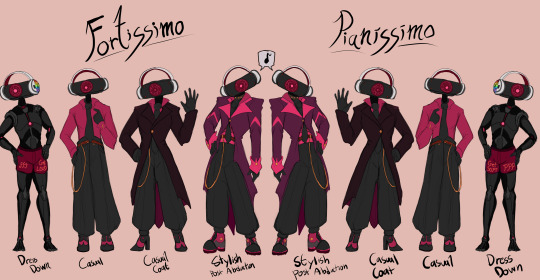
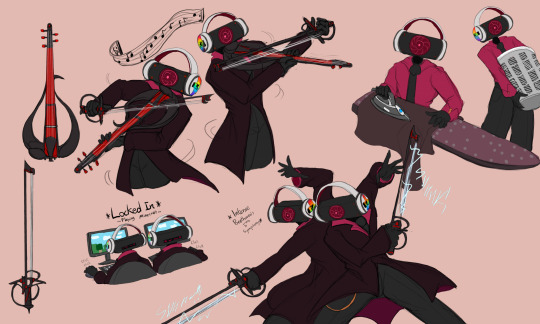
FINALIZED CONCEPT FOR THE TERRIBLE TWINS!
NAME: Fortissimo and Pianissimo; SM-1023 and SM-1024
NICKNAMES: The Terrible Twins, The Mayhem Maestros, Thing One and Thing Two (Paralipsis), The Dynamic Duet (Tremolo)
ALLIANCE CLASS: Speakermen; Small Units (they are second shortest in the group)
WORK CLASS: Unknown; Sonar Experts at Outpost 51 (They kind of just showed up and the Supervisor gave em a job)
GENDER: They/Them
CLASSIFICATION: Artificial Mind (Non-human origin; presumed)
RANK: Communications Specialists
Not much is known about the background of Fortissimo and Pianissimo and when asked, they usually just give a submissive strong. The two are mutes, by choice as they are not deaf and have nothing physically stopping them from speaking, they simply seem not to want to.
The two tend to either be interested in something or dismiss it, as noted about how they slack off completely with their actual jobs and usually focus on their interests in fashion, music, and gaming instead. When they must, they are able to hold their own in a fight, although are noted to be experts in traps, sabotage, and breaking into places they aren't suppose to be in.
(MORE LORE UNDER THE CUT! <3)
The Twins have a deep love of classical music and any music that doesn't really have words to it, often picking out certain classical pieces to assign to people as "theme songs" to play when they see someone.
Both are accomplished musicians, both composing and performing their own music. Both have a preference for the violin, but are also known to be able to play piano, various percussive instruments, cello, bass, and guitar.
It is not uncommon for Outpost 51 to be filled with the calming sounds of symphonic music as the two work out their latest works on their breaks and in the evenings.
The two never speak, having selective mutism, as there is nothing physically wrong with either one to prevent them from speaking. Occasionally one may hear a chuckle or hum. Still they prefer to speak, if at all, in sign language, and even then very rarely. The two tend to stare at people or play snippets of classical music to convey things.
Although at first glance, they may seem identical, they are not entirely so. The biggest difference is that Fortissimo is LEFT handed and favors the left side and Pianissimo is RIGHT handed and favors the right side. They always sand with Fortissimo on the left and Pianissimo on the right and seem very strict about this. Also Fortissimo plays music louder and Pianissimo plays music softer.
The two love fashion and do the laundry for Outpost 51 to make sure everyone's clothes are mended, cleaned, folded, and pressed. They even have a special cart they push around for "fashion emergencies" when they spot someone in need of "fashion help". They have been known to corner visitors and clean up their fashion tastes.
The two are very good at setting traps and sabotaging systems. When they don't want to work, they are known to break the sonar system from time to time and play innocent. They sometimes sabotage systems for fun as well as setting up traps. The traps though are usually harmless pranks. However, they are very capable of setting far more lethal and gruesome tests if they feel there is a danger.
They are rather small for speakermen, being slight of frame and height. Only Medic is actually shorter than them, but that is by a mere inch or two.
The two do everything together or not at all. Trying to get them to do separate tasks makes them upset and agitated. They just have to be on the same task, even if that is out of sight, they seem to be able to know what the other is doing at all times.
Their violin bow is actually a weapon that is a glorified electric bug-zapper of a weapon that can leave poor alliance members with a very nasty sting or unconscious and they know how to use it if they get pushed.
They are terrified of Paralipsis and never put up a fuss about his orders and often are on call to get the supervisor up and presentable for meetings when he bothers to do his job. In return, Paralipsis doesn't really care if they do their job or not. This means they usually are playing video games while they should be working.
The two love to clap for "encouragement" when they see someone really mess up. The general understanding is they are being entirely sarcastic.
They are known to be neat freaks and punctual about times, often giving long silent stares at those who show up late or make a mess...except Paralipsis. The Supervisor can do what he wants as long as he doesn't show up.
#skibidi toilet oc#skibidi toilet fandom#Speakermen#The Terrible Twins#Fortissimo and Pianissimo#Speakermen OC#They are the home alone fools#Will prank and drop a bucket of paint on someone#Slacking off is their profession
10 notes
·
View notes